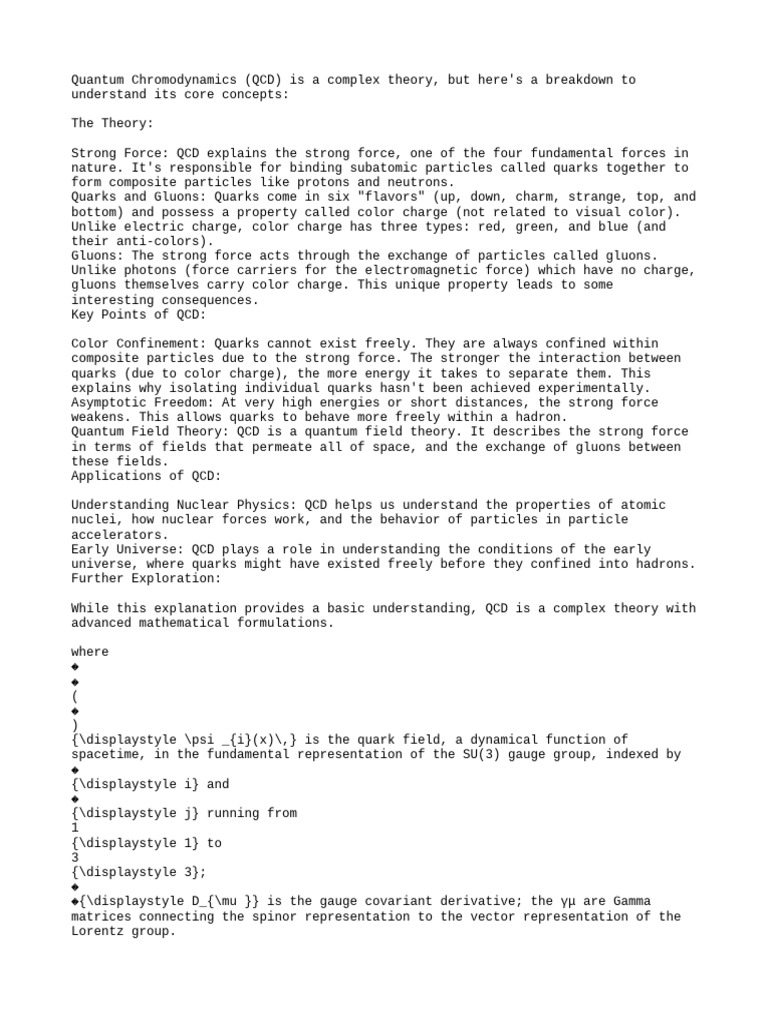Quantum Chromodynamics, often abbreviated as QCD, is a fundamental theory in the field of particle physics that seeks to explain the strong force—the interaction that holds atomic nuclei together. At first glance, it may appear as a niche subject only for physicists, yet its implications reverberate throughout the understanding of matter itself. By dissecting the complexities of QCD, we can tap into some engaging observations that lead us to a profound fascination with the universe.
To embark on this exploration, it is essential to demystify the terminology associated with quantum chromodynamics. In layman’s terms, the word “chromodynamics” stems from the Greek word “chroma,” meaning color. However, unlike the colors we perceive in our everyday environment, the “colors” in QCD refer to a property of quarks—the fundamental constituents of protons and neutrons. This property is crucial as it dictates how quarks interact with one another through the strong force mediated by particles called gluons.
The strong force is one of the four fundamental forces of nature, alongside gravity, electromagnetism, and the weak force. What sets the strong force apart is its extraordinary strength and its short range. While gravity is universally attractive and long-range, the strong force operates at an incredibly close distance within atomic nuclei. Without the influence of this force, protons would repel each other due to their like positive charges. QCD, therefore, serves as a cornerstone of the Standard Model of particle physics, which encapsulates our best understanding of the interactions between the known particles that comprise the universe.
Central to quantum chromodynamics is the interaction between quarks and gluons. Quarks are elementary particles that come in six “flavors”—up, down, charm, strange, top, and bottom—each possessing a specific mass and charge. These quarks are never found in isolation due to a phenomenon known as confinement, a dynamic unique to QCD. Instead, they are bound together in groups to form protons, neutrons, and other particles collectively known as hadrons. Gluons, on the other hand, serve as the exchange particles for the strong force. They carry the “color” charge and facilitate the interactions between quarks. Just as photons mediate electromagnetic forces, gluons act as the messenger particles of quantum chromodynamics.
An intriguing aspect of QCD is its reliance on non-abelian gauge symmetry. This convoluted mathematical framework allows for the immense complexity inherent in particle interactions. In simpler terms, it means that the interactions between quarks and gluons are far more intricate than those seen in other forces, such as electromagnetism. Such complexity begets phenomena like asymptotic freedom, wherein quarks behave as though they are nearly free from one another at extremely high energies, only to become tightly bound at lower energies. This paradoxical nature of quarks is mind-boggling and a testament to the enigmatic fabric of our universe.
Moreover, quantum chromodynamics introduces concepts that extend beyond mere particle interactions. One can observe that the phenomena observed in QCD mirrors the underlying principles of various fields—everything from cosmology to the behavior of materials at quantum levels. The immense energy released in collisions at particle accelerators like the Large Hadron Collider (LHC) leads to the creation of a quark-gluon plasma, a state of matter theorized to have existed just moments after the Big Bang. Understanding QCD’s role in these primordial conditions not only informs us about the earliest moments of the universe but raises philosophical inquiries about our existence, the fabric of time and space, and the dimensions beyond human perception.
Furthermore, one must also contemplate the implications of QCD on the structure of matter. It envelops the idea that the mass of protons and neutrons, which constitute the bulk of the universe’s ordinary matter, is not simply a product of the quark masses themselves but arises predominantly from the energy associated with the strong force, according to Einstein’s famous equation (E=mc^2). Interestingly, this links mass with energy in a manner that fuels the quest for deeper understanding in the realm of theoretical physics.
Enthusiasts of science are invariably captivated by the intricate world of quantum chromodynamics, not solely for its theoretical foundations but also for its potential to explain unanswered questions about the universe. The ongoing research in this domain can lead to practical applications as well, such as advancements in nuclear technology, medical imaging, and materials science, ultimately benefiting humanity at large.
In conclusion, quantum chromodynamics is much more than an academic curiosity confined within the realm of theoretical physics. It embodies the curiosity of humankind, a quest to unravel the mysteries of creation itself. By addressing the strong force and the interactions between quarks and gluons, QCD provides insights into the very essence of matter. As we delve deeper into its complexities, the fascination with quantum chromodynamics continues to burgeon, revealing layers of understanding that connect the microscopic workings of the universe to the macroscopic world we perceive.












